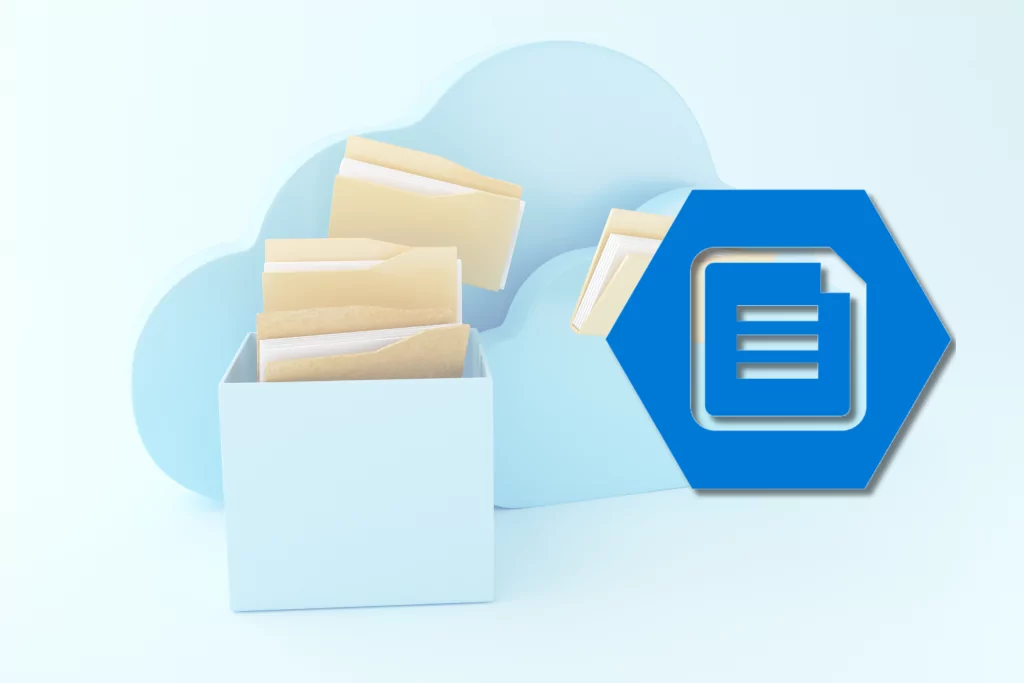Découvrez Azure Files, une solution de stockage cloud gérée, sécurisée et sans serveur offerte par Microsoft. Ce service permet la création et la gestion de partages de fichiers en utilisant les protocoles SMB et NFS standard de l’industrie. Il offre une variété d’options de stockage, y compris des fichiers transactionnels optimisés, et s’adapte à vos besoins grâce à une tarification flexible sans frais initiaux. Découvrez également comment Azure Files se distingue de Azure Blob et SharePoint en termes de gestion des fichiers.
Meet Azure Files, a managed, secure, serverless cloud storage solution from Microsoft. This service allows the creation and management of file shares using industry standard SMB and NFS protocols. It offers a variety of storage options, including optimized transactional files, and scales to your needs with flexible pricing with no upfront costs. Also learn how Azure Files differs from Azure Blob and SharePoint in terms of file management.
Overview of Azure Files
Azure Files is a flexible and versatile cloud storage service ideal for businesses of all sizes. It allows you to create file shares accessible from anywhere, which facilitates collaboration between geographically dispersed teams.
Users can choose from multiple redundancy options to ensure data availability and durability. Whether you need local, cross-region, or geo-redundancy, Azure Files offers solutions for various resilience scenarios.
Integration with Azure File Sync helps quickly sync files between on-premises servers and the cloud, reducing latency and improving performance. This feature is especially useful for businesses with remote offices or branch offices.
Azure Files also supports SMB and NFS protocols, enabling broad compatibility with different operating systems and applications.
What is Azure Files?
Azure Files is a file storage service fully managed by Microsoft. It allows businesses to create file shares that can be accessed from anywhere, whether from cloud or on-premises environments.
Using industry-standard SMB and NFS protocols, Azure Files provides seamless integration with various operating systems like Windows, Linux, and macOS. This compatibility makes it easy to migrate files to the cloud without disrupting existing operations.
One of the key benefits of Azure Files is the ability to sync files with on-premises servers via Azure File Sync. This feature reduces latency and improves file access performance.
Azure Files also provides data redundancy options to ensure data availability and security. Users can choose between local, inter-regional or geo-redundancy depending on their resilience needs.
Services offered by Azure Files
Azure Files Sync
Azure File Sync is a hybrid solution designed to extend the capabilities of Windows file servers to the cloud. It allows you to centralize your organization’s file shares in Azure Files while maintaining the flexibility and performance of local servers.
Azure File Sync turns your servers into fast caches for your Azure file shares. This allows quick local access to frequently used files, while storing less-used data in the cloud to optimize local space.
This solution also offers backup and recovery capabilities, integrating Azure Backup Services to protect your data without requiring on-premises backup infrastructure. For example, if an on-premises server fails, users can access files from another server configured with Azure File Sync within minutes.
Azure File Sync supports multiple versions of Windows Server, ensuring broad compatibility and ease of deployment.
Azure Fileshare and its use
Azure Fileshare is a versatile file sharing service that centralizes files securely in the cloud. It uses SMB and NFS protocols to ensure wide compatibility with different operating systems like Windows, Linux and macOS.
File shares can be mounted simultaneously across on-premises or cloud deployments, providing unprecedented access flexibility. For example, a company can easily share files between its offices in Toronto and Vancouver.
Azure Files’ storage redundancy options are also a great plus. You can choose between local, cross-regional, or geo-redundant solutions, depending on your specific data resilience and availability needs.
Azure Fileshare is a versatile file sharing service that centralizes files securely in the cloud. It uses SMB and NFS protocols to ensure wide compatibility with different operating systems like Windows, Linux and macOS.
File shares can be mounted simultaneously across on-premises or cloud deployments, providing unprecedented access flexibility. For example, a company can easily share files between its offices in Toronto and Vancouver.
Azure Files’ storage redundancy options are also a great plus. You can choose between local, cross-regional, or geo-redundant solutions, depending on your specific data resilience and availability needs.
Explore Azure Files: navigation and management
To navigate and manage your file shares, use Azure Storage Explorer. This tool allows you to view, search and interact with your data through an intuitive interface. It offers features such as uploading and downloading files, managing permissions and storage levels.
Azure Storage Explorer supports Windows, macOS, and Linux operating systems. You can access it through the Azure portal or install the application on your local machine. Integration with Microsoft Entra ID (formerly Azure Active Directory) strengthens security by controlling access.
Here are some actions you can perform with Azure Storage Explorer:
- Create and delete file shares
- Configure access controls and permissions
- Sync files with Azure File Sync for quick access
These features simplify the management of your online files and ensure efficient collaboration.
The Azure Files recovery system
To restore files with Azure Files, there are several methods available. Azure File Backup uses recovery points to make the process easier. It is possible to recover specific files and folders from these points.
Azure Backup provides an integrated solution to protect data against loss. You can restore files directly from the Azure portal with just a few clicks. This helps reduce interruptions in the event of a disaster.
Here are the steps for effective restoration:
- Access the recovery point through the Azure interface.
- Mount the recovery point on your local machine.
- Copy the desired files to their final destination.
The flexibility of Azure Files also allows you to open application files like SQL and Oracle directly from recovery snapshots. This feature simplifies the management of critical databases without requiring a full restoration first.
How Azure Files compares to other services
Azure Files vs Blob: What is the difference?
Azure Files and Azure Blob Storage are two separate services, each with their own use cases. Azure Files is designed to provide managed file sharing, similar to a traditional file server. It uses SMB and NFS protocols, allowing easy access from local and cloud environments.
Azure Blob Storage, on the other hand, is optimized for storing massive unstructured data. It is ideal for scenarios such as archiving, backup and big data analysis.
Here are some key differences between Azure Files and Blob Storage:
- Data type: Azure Files is suitable for structured files, while Blob Storage handles unstructured data like videos and images.
- Access: Azure Files can be mounted as a network drive, while Blob Storage is accessible via REST APIs.
- Use case: Use Azure Files for applications requiring file sharing, and Blob Storage for applications requiring large-scale storage of unstructured data.
Azure Files vs SharePoint: points of divergence
Azure Files and SharePoint differ in particular in their use cases. SharePoint is ideal for document collaboration and integration with other Microsoft 365 apps like Teams. For example, it allows a team to work simultaneously on the same Word document, thus facilitating real-time collaboration.
In contrast, Azure Files is designed for more traditional file storage scenarios, providing compatibility with SMB and NFS protocols. It is particularly suitable for businesses requiring network file shares accessible from on-premises and cloud environments.
In terms of performance, Azure Files offers two tiers: standard and premium. The premium tier uses SSDs for increased performance, ideal for applications requiring rapid data access. In summary, choosing between Azure Files and SharePoint depends on your specific collaboration and storage performance needs.
Azure Files architecture
Optimizing transactions with Azure Files
To optimize transactions with Azure Files, several strategies can be implemented. One approach is to use the appropriate storage tiers for your specific workloads.
File shares can be classified into the following levels:
- Optimized for Transactions: Ideal for workloads requiring a large number of transactions at a low cost.
- Hot: Suitable for frequently accessed data.
- Sporadic: Perfect for rarely accessed data, providing savings on storage costs.
Using Azure File Sync can also improve efficiency. This solution helps synchronize your local files with the cloud, reducing latency and improving access performance.
Finally, monitoring metrics like IOPS (input/output operations per second) and latency can help identify bottlenecks and adjust configurations accordingly.
Azure Files REST API and its benefits
The Azure Files REST API offers several notable benefits. First, it allows easy integration with a variety of programming languages, thanks to SDKs available for C#, Java, Python, JavaScript, and Go. This simplifies application development and integration.
Next, this API makes it easier to manage file shares through HTTPS requests, enabling operations such as creating, reading, and deleting files. Users can automate file management tasks and improve their productivity.
Additionally, the Azure Files REST API supports authentication via Microsoft Entra ID, providing role-based access control (RBAC). This strengthens security and permission management, ensuring that only authorized users can access files.
Finally, the API allows you to add value-added services, such as antivirus or backup solutions, directly to Azure file shares. These integrations improve the functionality and protection of data stored in the cloud.
Understanding storage on Azure Files
Managing storage with Azure Files Manager
Azure Files Manager makes managing your online storage accounts a breeze. It allows you to upload, download, and manage various file types and Azure storage entities, such as blobs and managed disks. This centralized management simplifies the work of administrators by providing a clear overview of all stored resources.
Users can also configure storage permissions and access controls to ensure data security and privacy. Azure Files Manager allows you to manage multiple subscriptions and regions, ensuring maximum flexibility.
Here are some key features::
- Configuring storage levels and access rules.
- Viewing and previewing data before downloading.
- Extension management to add new features according to specific needs.
The intuitive user interface makes these operations accessible even for those with little technical experience.
Azure Browser for simplified file access
Using Azure Browser greatly simplifies accessing files stored on Azure Files. It allows users to view and manage their files directly from a web browser, without the need for complex configurations or additional software.
Azure Browser offers several advantages::
- Universal Access: Files can be accessed from any internet-connected device, whether desktop, laptop or tablet.
- Reinforced security: Connections are secured by HTTPS protocols, guaranteeing the confidentiality of the data exchanged.
- Simplified management: You can easily upload, delete or organize your files, and even assign access permissions.
Additionally, Azure Browser integrates seamlessly with other Azure services, making it easier to collaborate and share files across distributed teams. This solution is ideal for businesses looking to optimize their data management while ensuring fast and secure access.
Security and backup with Azure Files
Backup with Azure Files: how does it work?
The backup process with Azure Files begins by creating a Recovery Services vault. This vault is essential for storing recovery points and managing backup operations.
Next, you need to configure backup for your file shares. To do this, select Azure Files as the data source type and choose the appropriate Recovery Services vault.
Once backup is set up, Azure uses “snapshots” to capture the state of your files at specific time points. These snapshots are stored securely and can be restored in the event of data loss.
Backups are automated on a schedule you set, and you can also initiate backups on demand. For better security, it is possible to encrypt data during transit and at rest.
Finally, Azure Backup includes monitoring and alerting features to alert you of any potential issues.
Secure files with Azure Services
Azure Services offers several tools and mechanisms to secure your files effectively. For example, Azure Active Directory Domain Services (AD DS) enables robust authentication and detailed access control. This ensures that only authorized users can access file shares.
In addition to this, Azure Key Vault offers secure storage of secrets, keys, and certificates. This tool is essential for protecting sensitive information and automating its management. Azure Key Vault can be integrated with services such as Azure File Sync to enhance security.
For added protection, use Azure Security Center. This tool provides real-time security recommendations and alerts. It helps quickly identify and remediate potential vulnerabilities.
Azure also offers data encryption options, both in transit and at rest. Encryption ensures that your data remains confidential and protected from unauthorized access.
Azure Files pricing
Pay-as-you-go: understanding the business model
The pay-as-you-go business model for Azure Files has several advantages. You only pay for the resources you consume, with no upfront commitment or termination fees. This model includes variable costs based on two main factors: the storage space occupied and the number of transactions performed.
Here are some examples of costs:
- Storage: You pay based on the gigabytes used each month.
- Transactions: Operations such as reading, writing, and deleting files are billed individually.
This type of billing offers remarkable flexibility, especially for businesses whose storage needs may fluctuate. For example, a rapidly growing startup can benefit from this model by only incurring additional costs when its storage usage increases.
By using tools like Azure Cost Management, you can track and optimize your expenses in real time.
Is Azure Files a PaaS service?
Azure Files is effectively considered a PaaS (Platform as a Service) service. This Microsoft-managed service provides a complete platform for file storage in the cloud, without requiring any underlying infrastructure management by the user.
Users can simply create a storage account and configure file shares, all managed by Azure. Additionally, Azure Files provides high availability and redundancy features, ensuring continuity of services.
Here are some specific benefits of Azure Files as a PaaS service:
- Ease of management: No need to manage servers or updates.
- Scalability: Easily adjust resources as needed.
- Built-in security: Using Azure Active Directory for access control.
Thus, Azure Files allows companies to focus on their applications and data without worrying about infrastructure constraints.
In short
In conclusion, Azure Files presents itself as a robust and flexible cloud storage solution, ideal for businesses looking to modernize their infrastructure while maintaining compatibility with existing systems. Thanks to its synchronization capabilities with local servers, its redundancy options, and its integration with other Azure services, this solution meets the varied needs of organizations for secure and efficient file sharing. Whether you have distributed offices or want to optimize your file management in the cloud, Azure Files provides a cost-effective and scalable approach to supporting your operations.




